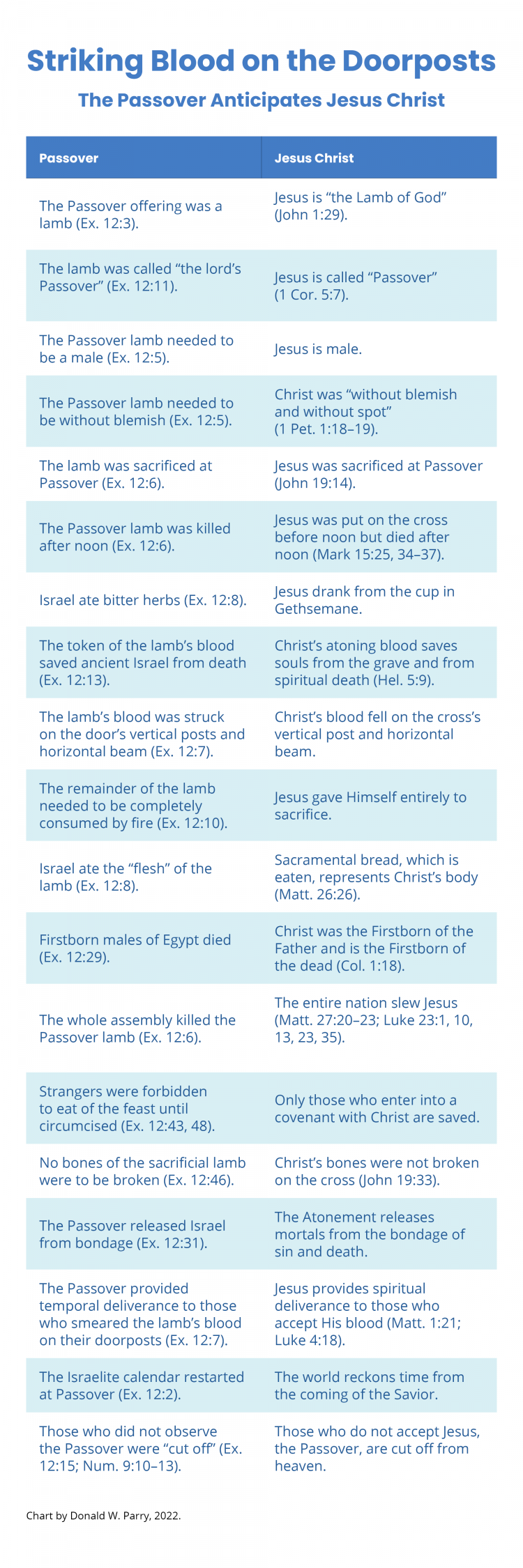You are here
Striking Blood on the Doorposts: The Passover Anticipates Jesus Christ
| Title | Striking Blood on the Doorposts: The Passover Anticipates Jesus Christ |
| Publication Type | Book Chapter |
| Year of Publication | 2022 |
| Authors | Parry, Donald W. |
| Book Title | The Jesus Christ Focused Old Testament: Making Sense of a Monumental Book |
| Pagination | 1102-103 |
| Publisher | Book of Mormon Central |
| City | Springville, UT |
Show Full Text
Enacted annually during the Jewish month of Abib (which occurs around March or April), the Passover recalls the occasion when God’s destroying angel “passed over” the obedient of Israel. This feast, as prescribed in Exodus 12, points to Jesus Christ’s atoning sacrifice. The sacrificed Passover lamb (Ex. 12:3–6, 46) prefigured Jesus Christ, who became the Lamb sacrificed for the sins of the world. The lamb was to be without blemish (Ex. 12:5), just as Jesus Christ would be without blemish (1 Pet. 1:18–19), and the Passover lamb had to be a male (Ex. 12:5), perhaps prefiguring Jesus’s gender.
Further, the feast encompassed rituals and commandments that anticipated Jesus’s death on the cross—His blood would spill on the cross, He would be killed after noon, and a large assembly would kill Him. In fact, the correspondences between the Passover and Jesus Christ’s death are so notable that Paul named Jesus “Our Passover” (1 Cor. 5:7). John the Baptist proclaimed Him to be “the Lamb of God, which taketh away the sin of the world” (John 1:29).
On the night of the first Passover, Israelites ensured that the destroying angel would pass over them by placing the Passover lamb’s blood on their doorposts before the destruction of firstborn males (Ex. 12:22). The Passover lamb’s blood symbolizes Jesus’s blood, which saves us from everlasting destruction.
The Passover teaches us how one may act as a substitute for another, because the lamb served as a proxy for the Israelite family so that the destroying angel would pass over them. In other words, God did not require human blood from family members, such as the firstborn son; instead, the lamb’s blood, which was smeared on the doorposts on the night of the Passover, served as a proxy, similar to the way that Jesus Christ’s blood saves us from the destructive elements of death and sin. Of course, those who failed to smear the doorposts, such as the Egyptians or perhaps negligent or disobedient Israelites, were not protected from death because the lamb’s blood did not deliver them from the destroying angel.
|
Passover |
Jesus Christ |
|---|---|
|
The Passover offering was a lamb (Ex. 12:3). |
Jesus is “the Lamb of God” (John 1:29).
|
|
The lamb was called “the lord’s Passover” (Ex. 12:11).
|
Jesus is called “Passover” (1 Cor. 5:7). |
|
The Passover lamb needed to be a male (Ex. 12:5).
|
Jesus is male. |
|
The Passover lamb needed to be without blemish (Ex. 12:5).
|
Christ was “without blemish and without spot” (1 Pet. 1:18–19). |
|
The lamb was sacrificed at Passover (Ex. 12:6).
|
Jesus was sacrificed at Passover (John 19:14). |
|
The Passover lamb was killed after noon (Ex. 12:6). |
Jesus was put on the cross before noon but died after noon (Mark 15:25, 34–37). |
|
Israel ate bitter herbs (Ex. 12:8).
|
Jesus drank from the cup in Gethsemane. |
|
The token of the lamb’s blood saved ancient Israel from death (Ex. 12:13).
|
Christ’s atoning blood saves souls from the grave and from spiritual death (Hel. 5:9). |
|
The lamb’s blood was struck on the door’s vertical posts and horizontal beam (Ex. 12:7).
|
Christ’s blood fell on the cross’s vertical post and horizontal beam. |
|
The remainder of the lamb needed to be completely consumed by fire (Ex. 12:10).
|
Jesus gave Himself entirely to sacrifice. |
|
Israel ate the “flesh” of the lamb (Ex. 12:8). |
Sacramental bread, which is eaten, represents Christ’s body (Matt. 26:26).
|
|
Firstborn males of Egypt died (Ex. 12:29). |
Christ was the Firstborn of the Father and is the Firstborn of the dead (Col. 1:18).
|
|
The whole assembly killed the Passover lamb (Ex. 12:6). |
The entire nation slew Jesus (Matt. 27:20–23; Luke 23:1, 10, 13, 23, 35).
|
|
Strangers were forbidden to eat of the feast until circumcised (Ex. 12:43, 48). |
Only those who enter into a covenant with Christ are saved.
|
|
No bones of the sacrificial lamb were to be broken (Ex. 12:46). |
Christ’s bones were not broken on the cross (John 19:33).
|
|
The Passover released Israel from bondage (Ex. 12:31). |
The Atonement releases mortals from the bondage of sin and death.
|
|
The Passover provided temporal deliverance to those who smeared the lamb’s blood on their doorposts (Ex. 12:7). |
Jesus provides spiritual deliverance to those who accept His blood (Matt. 1:21; Luke 4:18).
|
|
The Israelite calendar restarted at Passover (Ex. 12:2). |
The world reckons time from the coming of the Savior.
|
|
Those who did not observe the Passover were “cut off” (Ex. 12:15; Num. 9:10–13). |
Those who do not accept Jesus, the Passover, are cut off from heaven. |
Terms of Use
Items in the BMC Archive are made publicly available for non-commercial, private use. Inclusion within the BMC Archive does not imply endorsement. Items do not represent the official views of The Church of Jesus Christ of Latter-day Saints or of Book of Mormon Central.
Bibliographic Citation
Scripture Reference
Subscribe
Get the latest updates on Book of Mormon topics and research for free

